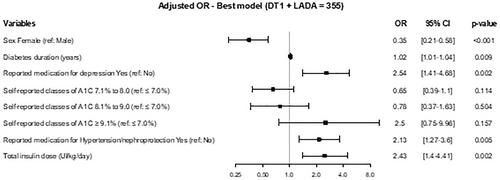Overweight and Obesity in People Living With Type 1 Diabetes: A Cross-Sectional Analysis of the BETTER Registry
Abstract
Aims
The prevalence and associations of overweight and obesity in Canadian adult people living with type 1 diabetes (PWT1D) are poorly documented. In a cohort of PWT1D patients, this study assesses (i) overweight and obesity frequencies and associated PWT1D clinicodemographic characteristics, (ii) diabetes characteristics, and (iii) the use of noninsulin adjunctive agents.
Materials and Methods
Cross-sectional analysis of self-reported data from the BETTER registry: 1091 adult PWT1D (aged 44.4 ± 15.0 years; 32% HbA1c<7% [53 mmol/mol]) classified by BMI classes: underweight combined with normal weight, overweight, or obesity. Bivariate analyses were used to identify associations between BMI classes, diabetes characteristics, complications, and treatments.
Results
Overweight and obesity affected 34.6% and 19.8% of participants. Compared to underweight + normal weight, PWT1D with overweight/obesity was associated with male sex, higher age, lower education level, longer diabetes duration, and higher total insulin doses and use of cardiorenal therapies (all p < 0.001). Compared to other PWT1D, those living with obesity reported higher HbA1c (p < 0.05), less frequent hypoglycemia (p < 0.05), more cardiovascular diseases (p < 0.003), retinopathy, neuropathy, depression treatment as well as noninsulin adjunctive agent use (all p < 0.001). Logistic regression showed that living with overweight/obesity was associated with male sex, being treated for cardiorenal therapies, depression, diabetes duration, and total daily insulin doses.
Conclusions
Overweight or obesity affects over half of adult PWT1D in the Canadian BETTER registry and is associated with higher HbA1c levels, higher total daily insulin doses, more chronic diabetes complications and noninsulin adjunctive agent use, a worse cardiometabolic profile, and lower hypoglycemia frequency.


 求助内容:
求助内容: 应助结果提醒方式:
应助结果提醒方式:


